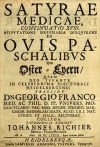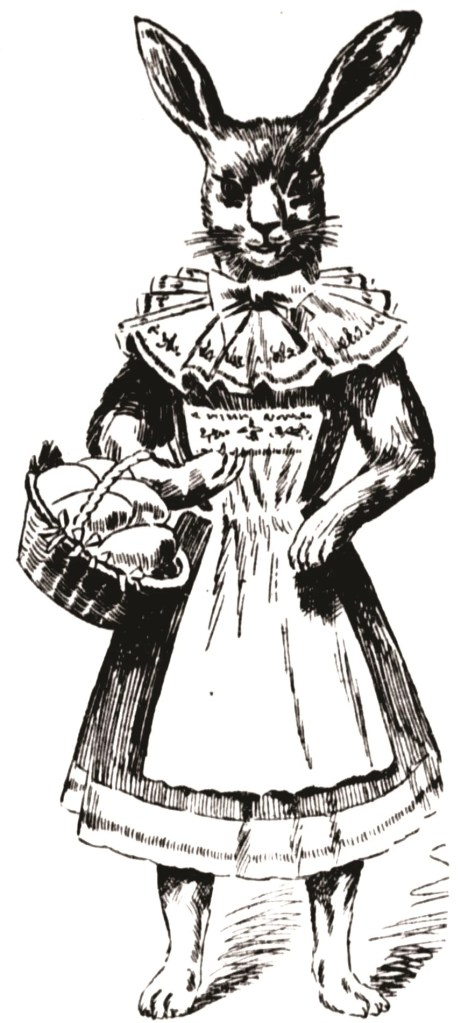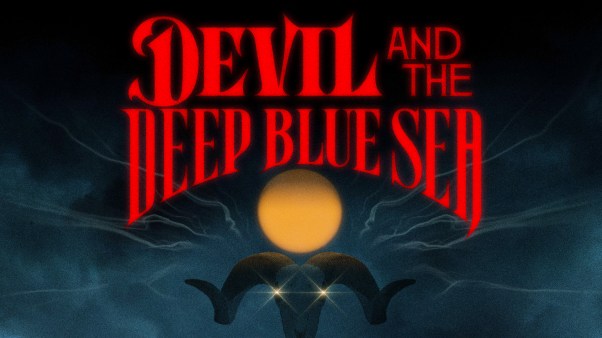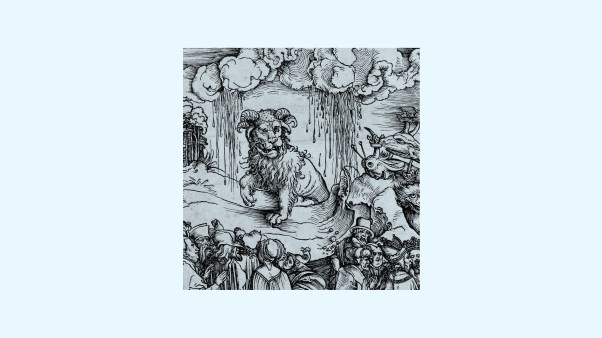One-hundred-fifty years ago, a German scholar complained that the Easter bunny was “inexplicable.” It remains so today. The egg-delivering hare has no obvious religious meaning nor clear connection to the holiday. It looks, in some ways, like an ancient myth that has been Christianized, but there is no known myth or fable that gave birth to this pesky rabbit.
And the true story, in fact, may not clear up much befuddlement. The Easter bunny was invented bit by bit and all at once, as people adopted, adapted, invented, and recreated pieces of an odd folk tradition to suit their celebrations.
Here are the tracks, such as they are, that the Easter bunny has left in our history:

692 – A church council in Constantinople, attempting to ensure religious practices are consistent across Christendom, prohibits eating dairy and eggs during Lent. Since boiled eggs keep longer, they become part of Easter celebrations.
1290 – English King Edward I orders 450 eggs decorated with dye and gold leaf to be given as gifts to the royal household on Easter.
1530 – Madonna of the Rabbit is painted by Titian, depicting the Virgin Mary with her hand on a white rabbit. Some believed the animal had the power to reproduce asexually.
1569 – A Dutch satire critiquing “Romish religion” lists decorated eggs as one of the ridiculous practices of the Catholic Church, along with candles, icons, palm branches, ashes, various hats, and vestments.
1572 – A Catholic priest is tied to a cross in Edinburgh and pelted with eggs. Reformer John Knox writes about it, putting down the first known use of the English phrase Easter eggs.

WHAT ARE THE CURRENT CAUSES OF EVANGELICAL FRAGMENTATION?
We fragment over what we regard as issues of principle, but often the real reason is personal, isn't it? When we're afraid, we withdraw into our own fellowships and ghettos with like-minded people where we feel secure. I'm aware of that fear in myself; it's part of our basic human insecurity. We're looking for contexts in which we can be supported rather than questioned.
I'm afraid that in some cases the cause of fragmentation is worse than that–it's a simple matter of ambition. There is a great deal of empire building among us. The only empire in which we should be interested is the kingdom of God, but I fear some people are building their own.
ON ISSUES OF PRINCIPLE, WHAT CONCERNS YOU MOST?
The uniqueness and finality of Jesus Christ in an increasingly pluralistic world is one–the debate about whether we go for exclusivism, inclusivism, or pluralism. Then there's the homosexual question, and the whole subject of sexual ethics.
So the church must recover its prophetic voice and reject both the idea that ethics evolve and the notion that love obliges us to capitulate to the modernist view of things.
We need a voice that is essentially positive, not just negative–for example, on the family, or the joy of sexual intercourse, and so on.
I don't know why we are always caught on the defensive and are reactive instead of proactive. I don't think it is something in our make-up as evangelicals. I sometimes wonder if it is that God has not given us many leaders who are visionaries.
The evangelical renaissance of the last 50 years has really been one of biblical scholarship. What we have lacked is systematic or creative theologians. I believe we have one in Alister McGrath; I am sure in England we had one in Jim Packer before he left the country. But we have very few theologians who are really far-sighted and give us a vision that will unite, inspire, and enthuse us.
DOES THIS LACK OF VISION FOR THE FUTURE HAVE SOMETHING TO DO WITH OUR PERCEPTION OF TRUTH LODGED IN ORTHODOXY? DOES THIS MAKE IT DIFFICULT TO BE CREATIVE AND TAKE RISKS?
Yes, there is something in that. Evangelicalism is fundamentally loyal to a past revelation, and because we are tied forever to what God did and said in the historic Jesus, we look back more often than we look forward.
In my debate with David Edwards [published as "Evangelical Essentials," InterVarsity], I drew a distinction between the liberal, the fundamentalist, and the evangelical. The liberal, to me, is like a gas-filled balloon which takes off into the ether and is not tethered to the earth in any way. The fundamentalist is like a caged bird, unable to escape at all. To me, the true evangelical is like a kite, which flies high but at the same time is always tethered. This demands a particularly unusual combination of loyalty to the past and creativity for the future.
ETERNAL PUNISHMENT
YOU HAVE FALLEN AFOUL OF SOME EVANGELICALS. SOME OF YOUR REFLECTIONS ON THE NATURE OF ETERNAL PUNISHMENT WERE CONSIDERED UNCONGENIAL TO ORTHODOXY BY SOME PEOPLE.
In "Evangelical Essentials", I described as "tentative" my suggestion that "eternal punishment" may mean the ultimate annihilation of the wicked rather than their eternal conscious torment. I would prefer to call myself agnostic on this issue, as are a number of New Testament scholars I know. In my view, the biblical teaching is not plain enough to warrant dogmatism. There are awkward texts on both sides of the debate.
The hallmark of an authentic evangelicalism is not the uncritical repetition of old traditions but the willingness to submit every tradition, however ancient, to fresh biblical scrutiny and, if necessary, reform.
HOW WOULD YOU ADVISE THEOLOGIANS TO THINK CREATIVELY IN THE LIGHT OF ORTHODOXY?
I don't think any of us is wise enough to express ourselves in a creative or questioning manner without first testing it within the Christian community. It is part of our loyalty to that community that we allow it to criticize or comment on what we may want to say.
DIALOGUE WITH LIBERALS
IN YOUR DEBATE WITH DAVID EDWARDS, YOU BOTH SEEMED TO REACH A GENUINE UNDERSTANDING OF AND RESPECT FOR EACH OTHER'S POSITIONS. DO YOU THINK THAT EVANGELICALS CAN LEARN FROM THE LIBERAL TRADITION?
David Edwards, a self-styled liberal, is crying out for a certain intellectual and academic freedom that can move with the times and respond to what he continually calls "the climate of educated opinion today," without being tethered to anything more than the love of God manifested in Jesus of Nazareth. I don't think that's an unfair summary. But all the time he's pulling at the tether, and that's the great difference between us.
He would say that evangelicals have a poor doctrine of the Holy Spirit, because we don't think the Spirit is continuing to teach and to "lead us into all the truth." I believe that text, John 16:13, is the most misunderstood and manipulated text in the whole of the Bible, because every branch of Christendom claims it.
It's a key text for the Roman Catholic Church. "He will lead you into all the truth." Who is the "you" here? Roman Catholics would claim it refers to the bishops as successors of the apostles. The liberal quotes it, and the charismatic quotes it: "He'll lead me," they say. But even the most elementary hermeneutical principle would tell us that the "you" means the apostles. Jesus said, "I have much more to say to you, but you cannot bear it now." Who is he addressing? The apostles. "But when the Spirit comes, he will do what I have not been able to do; he will lead you into the truth which I wanted to give you but you weren't able to take it." It must be the apostles. We cannot change the identity of the "you" in the middle of the sentence.
So the fulfillment of that prophecy is in the New Testament. The major ministry of the Holy Spirit has been to lead the apostles into all the truth and to give us in the New Testament this wonderful body of truth that remains our authority. That does not mean that the ministry of the Holy Spirit has ceased. It means that the role of the Holy Spirit has changed from the revelation of new truth to giving us a profounder perception and application of old truth–from revelation to illumination, if you like.
Although I may be overstating it slightly, I want to say that God has no more to teach us than he has taught us in Christ. It is inconceivable that there should be a higher revelation than God has given in his incarnate Son. But although God has no more to teach us, we have a great deal more to learn. And although he has no more to give us than he has given us in Christ, we have a great deal more to receive.
EVANGELICALS AND CATHOLICS
Some people feel that evangelicals adapt, eventually, to changing circumstances, whereas Catholicism stands firm like a rock. Those who say there is a loss of authority in our world are tending toward Rome…
Or Orthodoxy.
DO YOU THINK THERE IS SOMETHING ABOUT ROME THAT IS RIGHTLY ATTRACTIVE?
Yes. The true evangelical wants both liberty and authority. We want to ask questions, to think, to pry, to peer, to probe, to ponder. We want to do all these things, but within a framework of submission to an ultimate authority. But we're asking questions about our authority: what does it mean and how does it apply? So we experience an uneasy tension between liberty and authority.
I couldn't find a lodging place in either Catholicism or liberalism, because one seems to major on authority with little room for liberty, while the other emphasizes liberty with very little room for authority.
AUTHENTIC CHRISTIANITY INCLUDES THIS QUOTATION: "THE WORD CHRISTIAN OCCURS ONLY THREE TIMES IN THE BIBLE. BECAUSE OF ITS COMMON MISUSE WE COULD PROFITABLY DISPENSE WITH IT." SINCE THE WORD EVANGELICAL DOESN'T APPEAR AT ALL AND IS ALSO MISUSED, SHOULD WE DISPENSE WITH IT, TOO?
We could, in theory, for the same reason. The words that are used in the New Testament most frequently are believer, brother or sister, and child of God. There isn't a word that the Bible itself gives us to which we have to be loyal.
But the reason I want to stick with evangelical is a historical one. It has expressed a recognizable tradition, to which I still belong (and am proud and thankful to belong), and I want to take my stand not only on Scripture but in that tradition.
DOES IT ALARM YOU TO HEAR PEOPLE CALLING THEMSELVES "POSTEVANGELICAL"?
Yes. I don't know what they mean, but it does alarm me. If you are "post" anything, you are leaving something behind, and I want to know what it is. If it's our many faults and failures, fine, but that's not postevangelicalism, it's post-twisted-evangelicalism.
WHAT ARE THE WEAKNESSES OF EVANGELICALISM?
We've discussed our rugged individualism and the difficulty we have in cooperating with one another. Another weakness is our dogmatism. Instead of remembering Deuteronomy 29:29, we are dogmatic about even the things that God has kept secret. We're often not prepared to admit a certain agnosticism, which is a very evangelical thing, if we are alluding to what God has not revealed.
We have many weaknesses. I'm sure there are plenty more if I were to go on.
DO YOU THINK THAT OUR EMPHASIS ON "THE CHRISTIAN MIND" MAY HAVE PREVENTED US FROM FULLY AFFIRMING THE WISDOM TO BE FOUND OUTSIDE THE CHURCH?
What you mean is: Should we pay attention to the wisdom literature of other religions?
AND THE WISDOM OF PEOPLE WITH NO RELIGION?
Yes, we certainly should, even if with reservations and a desire to bring their thinking to the ultimate touchstone of biblical authority.
The key text is John 1:9, which says that the logos, the Son of God before the Incarnation, is the true light coming into the world and giving light to everybody. I believe that is the right translation–that he is constantly coming into the world. Indeed, he has never left it, because the world was made by him, and so he is in the world. He was in the world even before he came into it in the Incarnation, and as the logos he is giving light to everybody.
So, there is a certain light of common sense, reason, and conscience that everybody has, because they're also made in the image of God. To be sure, reason is fallen and fallible; nevertheless, it still operates.
For those two reasons, the divine logos and the human logos, if you like, we should listen respectfully to what other people are saying, even if at the end of the day we have the liberty to say, "No, that is wrong, because the Bible teaches otherwise."
GOD AND THE POOR
Authentic Christianity records you saying in 1981: "What will posterity see as the chief Christian blind spot of the last quarter of the twentieth century? I do not know. But I suspect it will have something to do with the economic oppression of the Third World and the readiness with which Western Christians tolerate it, and even acquiesce to it."
I did, I think, mention three blind spots. The nuclear horror was another one: evangelicals were the last people to make a statement about the immorality of weapons of indiscriminate destruction. I think the third one was the environment.
There is a great deal in the Bible about God's concern for the poor. Poverty–not poverty in the sense of simplicity, but in the sense of lacking the basic wherewithal for survival–is not really on our evangelical conscience yet. Partly because many people have not traveled and seen oppressive poverty with their own eyes, although they have seen the pictures on television.
ARE WE TOO READY IN THE WEST TO ACCEPT THE VIEW THAT A SUCCESSFUL CHURCH IS ALSO AN AFFLUENT ONE?
Because some people see prosperity as a mark of God's blessing, even today, they can't come to terms with poverty. We have to have the courage to reject the health-and-wealth gospel absolutely. It's a false gospel.
DO YOU THINK THE IDEA THAT GOD WANTS US TO BE COMFORTABLE BECAUSE HE LOVES US PRESENTS A THREAT TO A CUTTING-EDGE SPIRITUALITY?
Well, we're sitting in a very comfortable flat as we talk, and it's easy to say! But I do think that comfort is dangerous, and we should constantly be re-examining our lifestyle.
The New Testament is beautifully balanced on this. Paul avoids both extremes, not least in 1 Timothy 4 and 6. Asceticism is a rejection of the good gifts of the good Creator. Its opposite is materialism–not just possessing material things but becoming preoccupied with them. In between asceticism and materialism is simplicity, contentment, and generosity, and these three virtues should mark all of us.
It's not a question of rules and regulations about our income and how many rooms or cars we have. It's these principles of simplicity, contentment, and generosity over against covetousness, materialism, and asceticism that we have to apply to our living all the time. We need to give away what we are not using, because if we don't use it, we don't need it.
(continued)
Copyright © 1996 Christianity Today. Click for reprint information.
1682 – Physician Georg Franck von Franckenau describes children in the Heidelberg area hunting for “hare’s eggs” in herb gardens. It is the first known description of an Easter egg hunt.
1725 – In France, Louis XIV has a chocolate egg made to celebrate the end of the Lenten fast.
1800 – Johann Conrad Gilbert, a German artist in Pennsylvania, paints an Easter rabbit—the first known depiction in America.
1819 – Princess Victoria of Saxe-Coburg-Saalfeld, mother of the future Queen Victoria, moves from Germany to England and takes with her the tradition of Easter egg hunts.
1835 – Jacob Grimm, of Brothers Grimm fame, speculates without evidence about a possible connection between the Easter hare and an ancient pagan goddess.

1848 – The failure of a revolution leads to mass migration from Germany to the US. A few years later, “Easter hare” and “Easter rabbit” appear in print in America.
1874 – German philologist Adolf Holtzmann writes, “The Easter hare is inexplicable to me.” He imagines there could be a connection to a pagan goddess.
1874 – In England, an Anglican priest pays young men 100 eggs if they can kill a hare before 10 a.m. on Easter Monday.
1875 – Cadbury Chocolate starts to manufacture chocolate eggs for Easter in England.
1878 – President Rutherford B. Hayes invites children to roll Easter eggs at the White House after Congress forbids all playing on Capitol Hill, starting a long-running tradition.
1883 – German folklorist K. A. Oberle speculates the Easter hare tradition may have come from a myth about a pagan goddess turning a bird into a rabbit. He has no evidence such a myth ever existed.
1900 – A Michigan newspaper claims the story of a pagan goddess who turned a bird into a rabbit is “one of the oldest in mythology.” Others repeat the claim in stories about the “Easter bunny,” though there is no such ancient myth.
1903 – British retailers sell wooden eggs with toys inside for Easter.
1910 – A German newspaper notes the northern tradition of an Easter fox is dying out, replaced by the more popular Easter hare from the south.
1950 – A Pennsylvania department store sets up a photo booth where children can have their picture taken with the “Famous Easter Bunny” for $1. In Nashville, a department store sponsors a parade with the “Real Easter Bunny.”
1951 – An Easter bunny song, “Here Comes Peter Cottontail,” sung by Gene Autry, hits No. 3 on the Billboard charts in the US.












